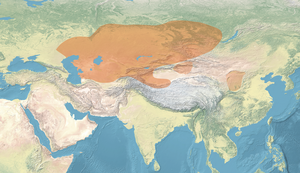Sagly-Bazhy culture
52°04′18″N 93°37′55″E / 52.071606°N 93.631836°E
Sagly-Bazy culture within the Saka realm ( ), and contemporary cultures and polities circa 325 BCE | |
| Geographical range | South Siberia |
|---|---|
| Dates | 500 to 200 BCE.[1] |
| Preceded by | Arzhan culture, Aldy-Bel culture |
| Followed by | Xiongnu Empire, Kokel Culture |

The Sagly-Bazhy culture or Sagly/Uyuk culture, also known as Chandman culture in Mongolia (Ulaangom cemetery), refers to the Saka culture of the Sayan mountains, in modern-day Tuva Republic.[1][2] It is the last stage of the Uyuk culture.
This period of Scythian culture covers a period from the 5th century BCE to the 2nd century BCE,[2] and follows the Arzhan culture (8th century BCE), and the Aldy-Bel culture (7th-6th century BCE) in the same location.[2] These Scythian cultures would ultimately be replaced by the Xiongnu Empire and the Kokel Culture.[2]
Nearby Saka cultures were the Tagar Culture of the Minusinsk Basin, as well as the Pazyryk Culture (ca. 500–200 BCE) in the Altai mountains and the Saka culture (ca. 900–200 BCE), to which the Sagly-Bazy culture was strongly related.[3][2][4] To the east was the Slab-grave culture.
The Sagly-Bazhy culture stopped to exist in the 2nd century BCE as a result of Xiongnu invasions.[5]
-
Animal style artifact Sagly-Bazhi II (Tuva).[6]
-
Bone arrowheads of the Chandmani culture, Western Mongolia
-
Bronze daggers of the Chandmani culture, Western Mongolia.[7]
-
Bronze mirrors, Chandmani culture, Western Mongolia
References[edit]
- ^ a b Jeong et al. 2020.
- ^ a b c d e Glebova, A. B.; Chistyakov, K. V. (1 July 2016). "Landscape regularities of human colonization of the Tuva territory in the Scythian time (8th–3rd centuries B. C.)". Geography and Natural Resources. 37 (3): 239. doi:10.1134/S1875372816030070. ISSN 1875-371X.
Uyuk culture [9, 12]. It derives its name from the Uyuk river, the valley of which, primarily within the Turan-Uyuk depression, is home to gigantic stone and earth kurgans with graves of tribal chiefs.
- ^ Jeong et al. 2020, "the Sagly/Uyuk culture (ca. 500–200 BCE) of the Sayan mountains to the northwest (also known as the Sagly-Bazhy culture, or Chandman culture in Mongolia), who had strong cultural ties to the Pazyryk (ca. 500–200 BCE) and Saka (ca. 900–200 BCE) cultures of the Altai and eastern Kazakhstan".
- ^ Murphy, Eileen M. (2013). "Iron Age pastoral nomadism and agriculture in the eastern Eurasian steppe: Implications from dental palaeopathology and stable carbon and nitrogen isotopes". Journal of Archaeological Science.
- ^ "The Culture of Tuva in the Scythian Era (Hall 30)". State Hermitage Museum.
- ^ Zhogova, Nina A.; Oleszczak, Łukasz; Michalczewski, Krzysztof; Pieńkos, Igor; Caspari, Gino (September 2023). "Identifying seasonal settlement sites and land use continuity in the prehistoric southern Siberian steppe – Zhelvak 5 (Tuva)". Archaeological Research in Asia. 35: 100467. doi:10.1016/j.ara.2023.100467.
- ^ Matsumoto, Keita (1 January 2021). "A SURVEY OF BRONZE AND EARLY IRON AGE TOOLS AND WEAPONS FROM NORTHERN MONGOLIA". Ancient cultures of Mongolia, Southern Siberia and Northern China: 332.
Sources[edit]
- Jeong, Choongwon; Wang, Ke; Wilkin, Shevan; Taylor, William Timothy Treal; Miller, Bryan K.; Bemmann, Jan H.; Stahl, Raphaela; Chiovelli, Chelsea; Knolle, Florian; Ulziibayar, Sodnom; Khatanbaatar, Dorjpurev; Erdenebaatar, Diimaajav; Erdenebat, Ulambayar; Ochir, Ayudai; Ankhsanaa, Ganbold; Vanchigdash, Chuluunkhuu; Ochir, Battuga; Munkhbayar, Chuluunbat; Tumen, Dashzeveg; Kovalev, Alexey; Kradin, Nikolay; Bazarov, Bilikto A.; Miyagashev, Denis A.; Konovalov, Prokopiy B.; Zhambaltarova, Elena; Miller, Alicia Ventresca; Haak, Wolfgang; Schiffels, Stephan; Krause, Johannes; Boivin, Nicole; Erdene, Myagmar; Hendy, Jessica; Warinner, Christina (12 November 2020). "A Dynamic 6,000-Year Genetic History of Eurasia's Eastern Steppe". Cell. 183 (4): 890–904. doi:10.1016/j.cell.2020.10.015. hdl:21.11116/0000-0007-77BF-D. ISSN 0092-8674.



![Animal style artifact Sagly-Bazhi II (Tuva).[6]](http://upload.wikimedia.org/wikipedia/commons/thumb/8/8e/Animal_style_artifact_Sagly-Bazhi_II_%28Tuva%29.jpg/200px-Animal_style_artifact_Sagly-Bazhi_II_%28Tuva%29.jpg)

![Bronze daggers of the Chandmani culture, Western Mongolia.[7]](http://upload.wikimedia.org/wikipedia/commons/thumb/9/91/Bronze_daggers_of_Chandmani-Sagil.jpg/154px-Bronze_daggers_of_Chandmani-Sagil.jpg)



